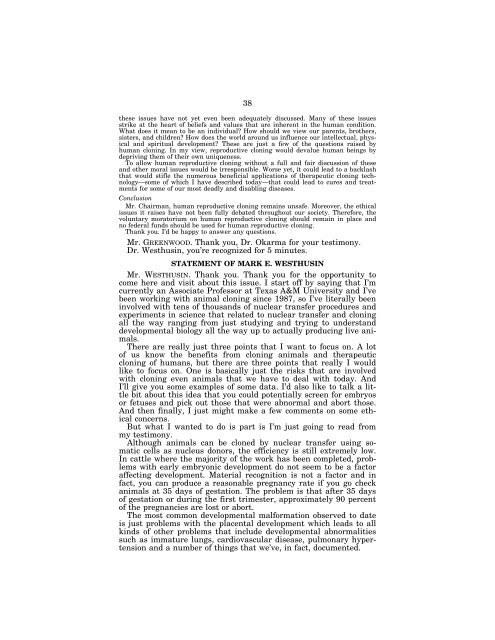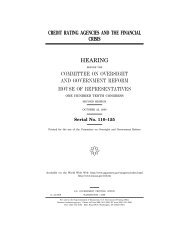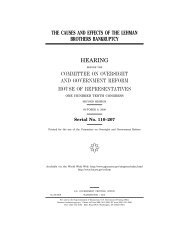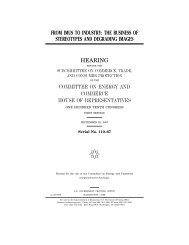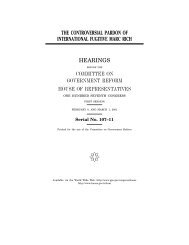38these issues have not yet even been adequately discussed. Many of these issuesstrike at the heart of beliefs and values that are inherent in the human condition.What does it mean to be an individual? How should we view our parents, brothers,sisters, and children? How does the world around us influence our intellectual, physicaland spiritual development? These are just a few of the questions raised byhuman cloning. In my view, reproductive cloning would devalue human beings bydepriving them of their own uniqueness.To allow human reproductive cloning without a full and fair discussion of theseand other moral issues would be irresponsible. Worse yet, it could lead to a backlashthat would stifle the numerous beneficial applications of therapeutic cloning technology—someof which I have described today—that could lead to cures and treatmentsfor some of our most deadly and disabling diseases.ConclusionMr. Chairman, human reproductive cloning remains unsafe. Moreover, the ethicalissues it raises have not been fully debated throughout our society. Therefore, thevoluntary moratorium on human reproductive cloning should remain in place andno federal funds should be used for human reproductive cloning.Thank you. I’d be happy to answer any questions.Mr. GREENWOOD. Thank you, Dr. Okarma for your testimony.Dr. Westhusin, you’re recognized for 5 minutes.STATEMENT OF MARK E. WESTHUSINMr. WESTHUSIN. Thank you. Thank you for the opportunity tocome here and visit about this issue. I start off by saying that I’mcurrently an Associate Professor at Texas A&M University and I’vebeen working with animal cloning since 1987, so I’ve literally beeninvolved with tens of thousands of nuclear transfer procedures andexperiments in science that related to nuclear transfer and cloningall the way ranging from just studying and trying to understanddevelopmental biology all the way up to actually producing live animals.There are really just three points that I want to focus on. A lotof us know the benefits from cloning animals and therapeuticcloning of humans, but there are three points that really I wouldlike to focus on. One is basically just the risks that are involvedwith cloning even animals that we have to deal with today. AndI’ll give you some examples of some data. I’d also like to talk a littlebit about this idea that you could potentially screen for embryosor fetuses and pick out those that were abnormal and abort those.And then finally, I just might make a few comments on some ethicalconcerns.But what I wanted to do is part is I’m just going to read frommy testimony.Although animals can be cloned by nuclear transfer using somaticcells as nucleus donors, the efficiency is still extremely low.In cattle where the majority of the work has been completed, problemswith early embryonic development do not seem to be a factoraffecting development. Material recognition is not a factor and infact, you can produce a reasonable pregnancy rate if you go checkanimals at 35 days of gestation. The problem is that after 35 daysof gestation or during the first trimester, approximately 90 percentof the pregnancies are lost or abort.The most common developmental malformation observed to dateis just problems with the placental development which leads to allkinds of other problems that include developmental abnormalitiessuch as immature lungs, cardiovascular disease, pulmonary hypertensionand a number of things that we’ve, in fact, documented.VerDate 11-MAY-2000 07:46 May 24, 2001 Jkt 000000 PO 00000 Frm 00042 Fmt 6633 Sfmt 6602 71495.TXT HCOM2 PsN: HCOM2
39I wanted to give you just some examples of just so you have anidea about the efficiency of this 4 or 5 different cases. In one case,we had a bull that we cloned that was 21 years old. We collectedcells. We produced 26 blastocysts from those, transferred those into11 recipients and got 6 pregnancies and o1 calf that went to term.When that calf went to term, we spent the first 2 to 3 weeks inintensive care with that calf, really trying to keep him alive. He developedalso Type 1 dependent diabetes which we don’t understandat all why that happened because you just don’t see that in cattleand he also had some immune problems.In a second case, we cloned a Charolais cow or attempted to dothat. To cut to the chase we transferred 37 embryos into 13 recipients.Six of there were diagnosed pregnant at 30 days. Only fourremained pregnant past 60 days. We got two calves, but both ofthem died, and died, obviously, due to complications related to thecloning.In another case, we had a Brangus cow that we worked on. Weproduced 43 embryos in that case where we transferred embryos.We produced only three pregnancies and none of those went toterm.And the point that I want to bring out with that, by giving yousome of these different examples, is that in not every case is everyanimal easily clonable. There are big differences between one animalmight work better than another, but in every case they seemedto show these abnormalities.I’m running out of time here, I’m sure, so I won’t talk about thelast part, but there’s just case after case of this.I wanted to show—these are just some slides that show thesekinds of things I’ve talked about, so this just shows the efficiencywhere it dropped of dramatically. This is the gestation loss that wesee between 30 and 90 days which is just horrendous and thenthese are some of the kinds of things that we see and so the topis the bull calf that we actually saved and he’s in ICU and he’s onrespirator just to keep him alive and in the lower right is obviouslyone that didn’t make it.I wanted to talk to you about, you know, the one on the lowerright and then relate it to those six clones. I guess one could almostthink about too, what’s going to happen if you get more than one?This is another one that I think was every interesting that westudied a group of 13 pregnancies that went into the third trimester.From these, only 8 calves were born alive. Four were stillborn.Three of the cows that actually were carrying the pregnanciesalso died within 7 days and then we ended up with actually sixcalves, but we had tremendous amount of loss.Now I want to, and these are just some examples, I wanted totalk about the aberrant plastintation so I’m running out of timehere and the different things that we see. But I wanted to bringthis up also and talk that there’d been some issues that one mightbe able to screen these embryos and really is not the case.We’re not going to be able to screen embryos for anything to tellwhether they’re abnormal or not. The reason is because if you lookat the karyotype, for instance, of cloned embryos, they all have normalkaryotypes and they have the normal number of genes. Theyalso have aberrant gene expression of various genes and we don’tVerDate 11-MAY-2000 07:46 May 24, 2001 Jkt 000000 PO 00000 Frm 00043 Fmt 6633 Sfmt 6602 71495.TXT HCOM2 PsN: HCOM2
- Page 1 and 2: ISSUES RAISED BY HUMAN CLONING RESE
- Page 3 and 4: C O N T E N T SPageTestimony of:Boi
- Page 5 and 6: ISSUES RAISED BY HUMAN CLONINGRESEA
- Page 7 and 8: 3Would human cloning lessen the wor
- Page 9 and 10: 5Chairman TAUZIN. Thank you, Mr. Ch
- Page 11 and 12: 7and cell therapy and beta cell dev
- Page 13: 9safety and the moral condition of
- Page 17 and 18: 13seen in the common phrase, being
- Page 20 and 21: 16a want of capacity to live were a
- Page 22 and 23: 18eight to ten weeks gestation as a
- Page 24 and 25: 20Washington v. Glucksberg ignores
- Page 26 and 27: 22tion decision. The father of ‘
- Page 28 and 29: 24been treated as ‘‘sui generis
- Page 30 and 31: 26Perhaps the three most compelling
- Page 32 and 33: 28are their genes. We know that chi
- Page 34 and 35: 30ago, Nobel Prize-winning biologis
- Page 36 and 37: 32Mr. JOHN. Thank you, Mr. Chairman
- Page 38 and 39: 34Mr. GREENWOOD. The Chair thanks t
- Page 40 and 41: 36to turn undifferentiated human pl
- Page 44 and 45: 40really have a clue what those gen
- Page 46 and 47: 42mately 150 days of gestation and
- Page 48 and 49: 44Hill JR, Winger QA, Long CR, Loon
- Page 50 and 51: 46clones will not change a bit by t
- Page 52 and 53: 48technologies, we’re able today
- Page 54 and 55: 50from the testes of infertile men
- Page 56 and 57: 52not be taken away from people, be
- Page 58 and 59: 54a result of this declaration, I w
- Page 60 and 61: 56Too much pressure, too many expec
- Page 62 and 63: 58requires some level of scientific
- Page 64 and 65: 60an abnormal person. So I think it
- Page 66 and 67: 62to the world, back to this earthl
- Page 68 and 69: 64which is not true for cow which i
- Page 70 and 71: 66Ms. BOISSELIER. University of Hou
- Page 72 and 73: 68Ms. BOISSELIER. Soon.Ms. DEGETTE.
- Page 74 and 75: 70Mr. ZAVOS. No, no. We believe tha
- Page 76 and 77: 72cloning process. And without that
- Page 78 and 79: 74have to look at the structure of
- Page 80 and 81: 76Mr. LARGENT. So the answer is no,
- Page 82 and 83: 78that very much and you are excuse
- Page 84 and 85: 80that people have incorrectly stat
- Page 86 and 87: 82My name is Dr. Thomas Murray. I
- Page 88 and 89: 84human subjects against irresponsi
- Page 90 and 91: 86might be born as a result of this
- Page 92 and 93:
88ever, it is not unusual for the g
- Page 94 and 95:
90Mr. DEUTSCH. Because there really
- Page 96 and 97:
92Ms. ZOON. When we found out about
- Page 98 and 99:
94Mr. GREENWOOD. The time of the ge
- Page 100 and 101:
96Be that as it may I think there a
- Page 102 and 103:
98There has been progress in the cl
- Page 104 and 105:
100may find that it is a terrible e
- Page 106 and 107:
102entists tried to get this ban ov
- Page 108 and 109:
104lies in our hands. And we face a
- Page 110 and 111:
106clude Ireland, Israel, Italy, Fr
- Page 112 and 113:
108strict IVF and similar high-tech
- Page 114 and 115:
110while ‘‘clone then love’
- Page 116 and 117:
112What Cloning Is Not—The ‘‘
- Page 118 and 119:
114And the largest group of people
- Page 120 and 121:
116The last piece to the legal puzz
- Page 122 and 123:
118cloning law on both scientific f
- Page 124 and 125:
120mendous potential human safety r
- Page 126 and 127:
122age him to do this research and
- Page 128 and 129:
124I realize there have been calls
- Page 130 and 131:
126‘‘from which I have no assoc
- Page 132 and 133:
128TO HAVE CHILDREN,’’ I ask th
- Page 134 and 135:
130of ourselves as humans in our pr
- Page 136 and 137:
132Our Genetic Science Task Force c
- Page 138 and 139:
134But this was also true in occide
- Page 140 and 141:
136So we utilized good science to d
- Page 142 and 143:
138egg and so on. What you’re tal
- Page 144 and 145:
140Mr. DEUTSCH. I think that’s ac
- Page 146 and 147:
142and dad? We all did that when we
- Page 148 and 149:
144Food, Drug and Cosmetics Act or
- Page 150 and 151:
146Mister Chairman, the embryo may
- Page 152 and 153:
148The current low rate of cloning
- Page 154 and 155:
150TIME magazine’s pictorial, ‘
- Page 156 and 157:
152John A. Robertson, University of


